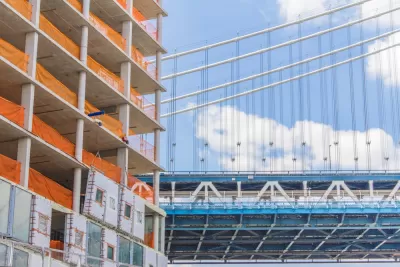Rejecting the common argument that cities can never be affordable because of high construction costs.

I have argued numerous times on Planetizen that increased housing supply would reduce rents. I recently read one counterargument that I had not fully addressed before: the claim that no amount of new housing will ever bring down urban rents because housing in high-cost, high-wage cities is expensive to build.* This argument rests on two assumptions: (1) that construction costs are the primary reason some cities are more expensive than others, and (2) if new housing is expensive, the median citywide rent will be equally expensive. I find neither assumption to be persuasive.
Admittedly, expensive cities do tend to have higher construction costs than more affordable costs—but this gap is far more modest than the gap in housing costs between high-cost and low-cost cities. For example, a study by the design firm EVStudio showed that the construction costs for a small apartment building in New York City were only about 30 percent higher than the costs of a similar building in Kansas City ($232 per square feet in New York, $181 in Kansas City). But rents in New York are far more than 30 percent higher; I pay about $5 per square foot for my Manhattan apartment, but paid just over $1 per square foot for a roughly comparable apartment in Kansas City (i.e., a doorman building in a fashionable intown neighborhood).
Similarly, the Lincoln Institute's land price database reveals that regional differences in construction costs lag behind differences in land costs: for example, construction costs in San Francisco are only about 60 percent higher than construction costs in Kansas City, but the median San Francisco-area house costs seven times as much due to differences in land costs. Thus, construction costs are not the main reason some cities are more expensive than others.**
Moreover, the suggestion that high construction costs for new buildings mean high rents for everyone seems to me to be based on the assumption that most people live in those new buildings. In a newly built suburb, this argument might make sense. But in most urban cores, the overwhelming majority of housing was built long ago: for example, in Manhattan only 1.2 percent of housing was built after 2010. So even if a new building rents for $4000 per month, it does not logically follow that the median citywide rent will be $4,000 per month.
In fact, it seems to me that new housing, no matter how expensive, may bring down the cost of older housing. Here's why: even an expensive new building takes away demand from the city's older buildings. For example, suppose that San Franciscans built half a million new housing units. No matter how expensive those units would be, that would be half a million fewer occupants for the city's existing housing stock. Such a collapse of demand would presumably cause rents to go down, or at least to increase less rapidly than usual. In fact, nothing like this has happened: for example, San Francisco has added 38,000 new jobs in recent years but only 4,000 housing units. Similarly, New York City has added half a million new jobs since 2000 and only 200,000 housing units.
In sum, new buildings in New York and San Francisco are more expensive than new buildings in Kansas City. But even though this is the case, more new buildings may mean lower rent for older buildings.
*A more moderate version of this claim focuses on high-rises; it seems to me that everything I write below applies with equal force to both high- and low-rise buildings.
**A more sophisticated anti-housing argument is that new housing will increase housing prices by increasing land prices. I have addressed that argument in this March post.

Planetizen Federal Action Tracker
A weekly monitor of how Trump’s orders and actions are impacting planners and planning in America.

Congressman Proposes Bill to Rename DC Metro “Trump Train”
The Make Autorail Great Again Act would withhold federal funding to the system until the Washington Metropolitan Area Transit Authority (WMATA), rebrands as the Washington Metropolitan Authority for Greater Access (WMAGA).

DARTSpace Platform Streamlines Dallas TOD Application Process
The Dallas transit agency hopes a shorter permitting timeline will boost transit-oriented development around rail stations.

The Tiny, Adorable $7,000 Car Turning Japan Onto EVs
The single seat Mibot charges from a regular plug in about as much time as an iPad, and is about half the price of an average EV.

Supreme Court Ruling in Pipeline Case Guts Federal Environmental Law
The decision limits the scope of a federal law that mandates extensive environmental impact reviews of energy, infrastructure, and transportation projects.

Texas State Bills to Defund Dallas Transit Die
DART would have seen a 30% service cut, $230M annual losses had the bills survived.
Urban Design for Planners 1: Software Tools
This six-course series explores essential urban design concepts using open source software and equips planners with the tools they need to participate fully in the urban design process.
Planning for Universal Design
Learn the tools for implementing Universal Design in planning regulations.
Roanoke Valley-Alleghany Regional Commission
City of Mt Shasta
City of Camden Redevelopment Agency
City of Astoria
Transportation Research & Education Center (TREC) at Portland State University
US High Speed Rail Association
City of Camden Redevelopment Agency
Municipality of Princeton (NJ)





























